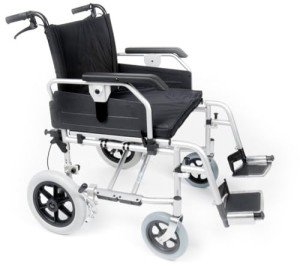Bariatric Wheelchair Seat Width
Seat Width
Having the right seat width is essential to wheelchair users who invest longer durations in their chairs. Too narrow a seat will trigger pressure on the hips and thighs which could cause sores or pressure points. Having too large a seat can likewise make it difficult for the user to reach the hand rims to move themselves or maneuver in small areas.
To determine the right seat width an individual would rest on a chair normally and have their measurement taken throughout their lap at the largest point which is normally their hips. bariatric wheel chair determining tape can be utilized to measure this, but a yard stick is preferred as it prevents people from covering the tape around their hips which would give an incorrect result.
The standard wheelchair seat width is 16" (narrow grownup), 18" (standard adult), and 20" (wide adult). For bariatric patients, a 24" seat is offered. This heavy-duty extra broad bariatric wheelchair from Medline features swing-away footrests, a carbon steel frame with rust- and chip-resistant chrome plating, and easy-to-clean vinyl upholstery. It has a weight capacity of 500 pounds.
Seat Depth
Generally, the seat depth of a bariatric wheelchair was included 2" to the measurement taken at the user's largest point (generally their hips). This was implied to accommodate additional layers of clothes that may be worn during cold weather. However, this practice is becoming less common as wheelchair users have the ability to spend more time indoors and are not using long coats. This makes the seat depth of a chair less essential when selecting a bariatric wheelchair. Nevertheless, it is still important to pick an alternative that uses adequate assistance for bigger users.

The Medline folding extra broad bariatric manual wheelchair features a comfortable 24" seat width and a sturdy slide tube silver vein frame. It also has an adjustable axle and tool-free raising legrests.
Seat Height
When it concerns determining the appropriate wheelchair seat width you must always measure from the user's widest point which is typically their hips. You will also need to think about whether the user is going to be using a winter coat as this may include 2" to the width needed.
When a wheelchair is in usage it ought to only be run on level surfaces with the wheel locks completely engaged. This is to prevent the chair from having the ability to move slopes that are 10 degrees or greater. It is likewise important to keep in mind that any activity that might move the center of gravity in the chair should be made with care. This includes reaching for products that need the individual to lean out of their seat or attempting to stand up from it.
Whenever you have the chair in use it is suggested that you frequently check it for damage and oil any areas that are considered necessary. For instance, the casters need to be lubricated by removing the caster fork and using a multi-purpose grease to use to the caster stem bearings. Also, the foot plates can be changed by loosening up the bolt and after that moving them to the wanted position. This permits the feet to sit comfortably on the footplate and prevents any pressure points from forming. This can be extremely uncomfortable for the user and if left unattended, can cause push sores.
Weight Capacity
Bariatric wheelchairs are designed to support more weight than standard wheelchairs. bariatric wheel chair makes them tougher and much better geared up to handle falls. They are likewise usually larger and larger, making them less maneuverable in tight spaces than basic wheelchairs. They need lorries with unique ramps and lifts to pack them, in addition to chauffeurs who understand how to best transport them from one area to the next.
When selecting a wheelchair, consider its weight capacity as it will be the primary determining aspect in whether it will accommodate your guest's requirements. The weight capacity of the chair is typically listed as a fixed load, implying that it indicates the quantity of weight the chair can easily hold while stalling. However, some producers also note an active load that is based on a drop test and can imitate the effect of someone sitting down in the chair. This may be a more trustworthy measurement of the weight limit, depending upon your requirements.
If you prepare to carry out activities that shift your center of gravity in the seat (such as reaching for items), make certain to have front casters pointed in a forward instructions and wheel locks engaged so the chair will not topple. Likewise, check that casters are oiled frequently to prevent extreme wear and abrasions. The lubrication procedure includes eliminating the fork, separating the caster from the wheel, and greasing the caster stem bearings with top quality multi-purpose grease.
